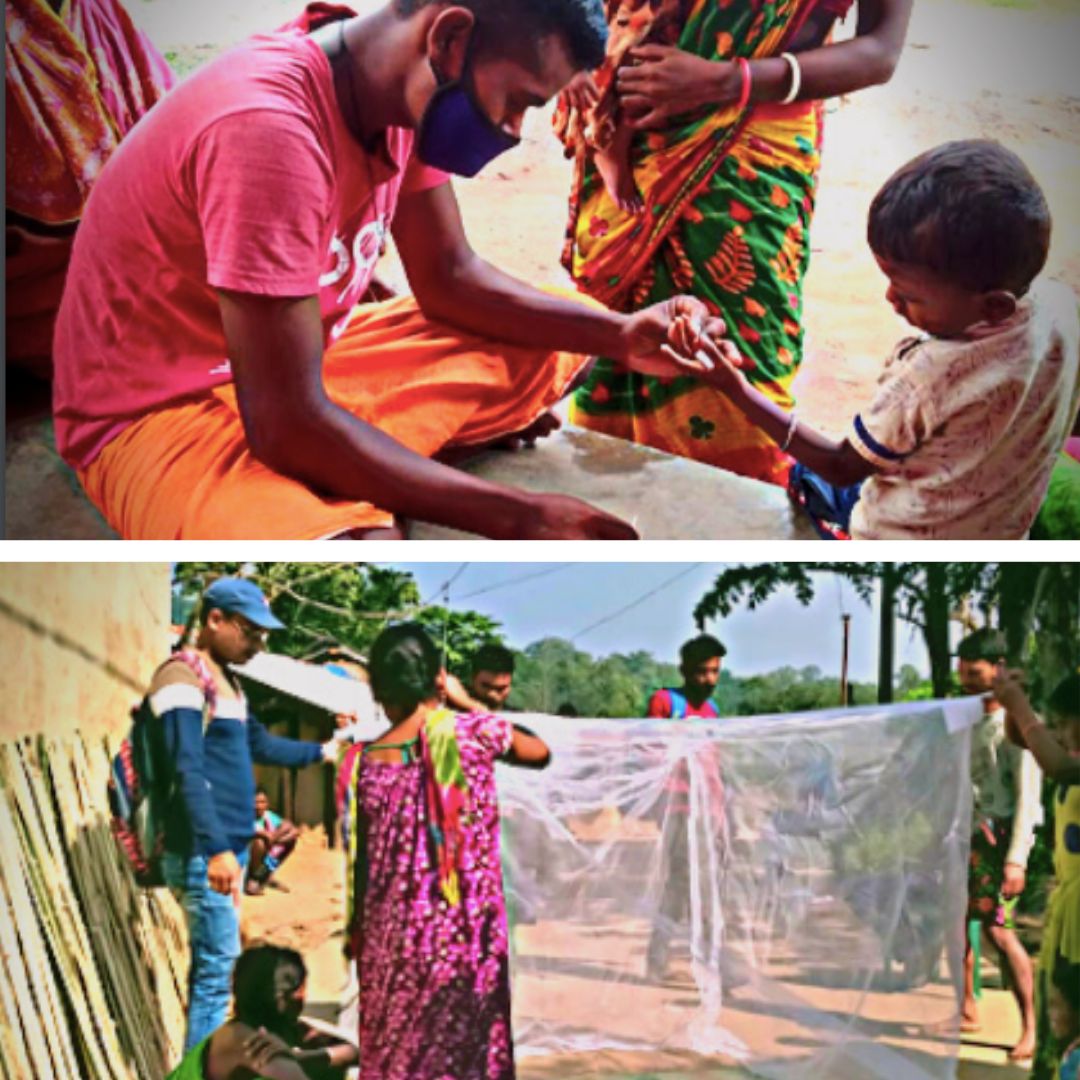
Image Credits: Malaria No More
This NGO Is Committed To Support India's 2030 Malaria Elimination Goal, Provides Last-Mile Healthcare Access
India, 23 July 2022 11:43 AM GMT
Editor : Snehadri Sarkar |
While he is a massive sports fanatic, his interest also lies in mainstream news and nitpicking trending and less talked about everyday issues.
Creatives : Tashafi Nazir
For most people, journalism sounds hectic and chaotic. For her, it's a passion she has been chasing for years. With an extensive media background, Tashafi believes in putting efforts on presenting a simple incident in the most interesting way.
‘Malaria No More’ began implementing its five-year strategy in 2018 to demonstrate and document innovations impacting the malaria fight, and mobilising the political will and resources needed to support India’s 2030 malaria-free goal.
Malaria has been one of India's long-standing public health problems. In India, the disease threatens a population of approximately 126 crores and is responsible for an estimated economic burden of ₹ 14000 crores.
However, since 2000, India has cut malaria cases by more than half and the number of malaria deaths by more than two-thirds. According to the WHO World Malaria Report 2019, as one of only two top 11 highest malaria burden countries to reduce malaria cases between 2017 and 2018, India registered a remarkable 28 per cent decrease in malaria cases and a 41 per cent decrease in malaria-related deaths. This is in addition to a 24 per cent decline in malaria cases between 2016 and 2017.
Ending Malaria remains a top government priority in India. In 2016, India introduced its first National Framework for Malaria Elimination (2016-2030). In 2019, the Government of India increased funding by more than 25 per cent for the National Vector Borne Disease Control Programme. It increased support as a donor to the Global Fund to Fight AIDS, Tuberculosis and Malaria.
While the nation has made immense progress in controlling Malaria thus far, various government, research bodies, private sector, bilateral organisations and NGOs have taken collective action to pave the way for a Malaria-free future.
Fuelling the fight against Malaria, an NGO called 'Malaria No More' envisions a world where no one dies from a mosquito bite.
Led by an experienced Indian team in Delhi and Bhubaneswar, Malaria No More's work in India began in 2016. It is working at the national level to help India develop the first mosquito-borne disease campaign to tackle Malaria, dengue and chikungunya.
In 2018, the NGO began implementing its five-year strategy to demonstrate and document innovations impacting the malaria fight and mobilising the political will and resources needed to support India's 2030 malaria-free goal.
In the same year, it set up India's first Strategic Support Unit (SSU) to combat Malaria in Odisha – one of India's highest malaria burden states. Since its inception, the SSU has provided technical and advocacy support to the Government of Odisha. In addition, MNM also has set up two District Program Management Units (DPMUs) in Koraput and Malkangiri– two districts that contribute significantly to the malaria burden of the state.
The state reduced malaria cases by more than 80% between 2017 and 2018 and emerged as an innovative leader in rapidly saving lives and reducing malaria cases and their toll on rural health systems.
"The National Programme has brought several interventions to contain malaria problem in the country from domestic resources. The external agencies have also funded the country by providing more fuel to control the disease and further eliminate it from the country. Through the combination of these interventions and diligent work done by the front-line health workers, the national programme has managed to control the disease burden efficiently," Pratik Kumar, Country Director, Malaria No More, told The Logical Indian.
Last Mile Access
A favourable climate, abundant sources of mosquito breeding and the lack of timely testing and treatment options for Malaria turn remote and inaccessible hamlets of Koraput and Malkangiri districts of Odisha into malaria hotspots.
Rigorous mapping and analysis were conducted to find high-endemic sub-centres and the target hotspots where geographical inaccessibility impeded the delivery of routine services. Nearly 38 surveillance workers (called Doots) were trained to conduct active and passive surveillance, case-based surveillance, and mass screening in the high endemic sub-centres. In addition, over 20 volunteers, selected from local tribal communities and called Saathis, were activated and trained to serve as 24/7 Micro-Fever Treatment Depots.
From treatment and referral, following up at any hours, and assisting and following up with hospitalisation and treatment completion, the Saathi has become a faithful companion of each malaria patient, executing the concept of 360° care.
For instance, Mangaraj Khilla and Balaram Khillo — two frontline health volunteers trained by Malaria No More— made a routine visit to the Golari household in a remote village of Odisha State in East India; they found 8-year-old Nabina Golari suffering from a high fever.
After counselling the family and performing a rapid test to confirm Malaria, they were able to administer a first dose of treatment on the spot. When Nabina's fever persisted, Mangaraj and Balaram took Nabina to a hospital facility 12 km away, where she continued treatment for Malaria. The girl could only be saved because of the timely and appropriate services delivered by the Doot/Saathi duo.
Doots and Saathis mobilise tribal communities and actively engage in each step of testing, treatment, and reporting in community-level mass screening camps under DAMaN*.
On detection of each malaria case, household surveys are undertaken. As part of this Reactive Active Surveillance, additional mass screening rounds are conducted when multiple issues are detected through passive surveillance and household surveys. Each case is reported to the subcentre on the same day and up to the district level within a week, irrespective of network availability.
Building Malaria-Resilient Community
The Doot/Saathi duo actively encourages pre-emptive prevention of and protection from Malaria in the community by conducting individual and group education.
They engage members of the community in the hope of inspiring action and building a malaria-resilient community in regions most vulnerable to this deadly yet preventable disease.
Doots and Saathis are part of their community and use this familiarity to build malaria-resistant communities by actively relaying health education messages, conducting regular surveys in villages to ensure consistent use of Long-Lasting Insecticidal Nets (LLIN), including remote and temporary 'kudia' houses usually outside the villages, organising periodic village cleaning drives etc.
India is soon approaching the end of the current National Strategic Plan, and thus needs to start conceptualising and initiating strategic discussions and cross-sectoral discourse on critical advocacy and technical issues to craft a robust Endgame National Strategic Plan for 2022-2027. In light of this, MNM India has been facilitating discussions through an ongoing Malaria Advocacy Campaign 'India's March Towards Malaria Elimination by 2030: Challenges, Opportunities, and The Way Forward', which was launched on the occasion of World Mosquito Day on the 20th August 2021.
In partnership with the Government of India and Odisha, MNM has created a dynamic toolkit called the Malaria Prediction and Planning Toolkit (MPPT).
The Malaria Prediction and Planning Toolkit (MPPT) is a 360° solution basket and uses an advanced data collection system and an integrated dashboard to serve the unique and dynamic needs of varying end users.
Using Mass Media To Impart Health Education
MNM and its partners have established the country's first national behaviour change communication (BCC) campaign called 'Bite Ko Mat Lo Lite' (BKMLL). This is the second year of this annual campaign, and this year it is disseminating key messages on malaria awareness, prevention, and testing through a character called 'Dadi'. The BKMLL campaign has amassed a reach of over 300 million Indians between 2020 and 2022. The campaign was disseminated across 25 states in India, using Facebook and its subsidiary platforms.
MNM plans to conduct media sensitisation workshops to encourage correct and timely reporting of the disease in the mainstream media to sustain community awareness and political attention to the issue.
"This is a high time to address another aspect of asymptomatic/afebrile Malaria to eliminate the disease, as the asymptomatic cases may be a threatening factor since the asymptomatic population is a carrier of malarial parasite. Therefore, the government must also focus on all such left-out areas to completely eliminate Malaria from the country," Pratik Kumar said.
 All section
All section














